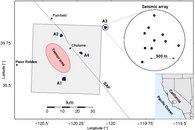During fall 2007 we deployed 4 small-aperture seismic arrays at the San Andreas Fault in the Cholame region for a time period of 6 weeks. All arrays consist of 10 seismic stations located within an area of roughly 1 km diameter, each. Distances between the arrays was between 30 and 50 km. While two of the arrays (A2, A3) are designed for optimal performance, one array (A1) consists of irregularly positioned stations and the fourth array (A4) is L-shaped. All seismic stations were equipped with a short period (4Hz) three-component seismic sensor and a GPS-synchronized data logger, recording at a sample rate of 200 SPS. During 6 weeks of continuous recording we identified more than 70 tremor events of different magnitude. Currently we process the data to get precize tremor locations.
Time Frame
- Fall 2007
Cooperations
- Gary Fuis (USGS Menlo Park)
Methods & Equipment
- seismological network
- 30 GIPP seismological station
Publications/Results
- Ryberg, T., Haberland, Ch., Fuis, G. S., Ellsworth, W. L., Shelly, D. R. (2010): Locating non-volcanic tremor along the San Andreas Fault using a multiple array source imaging technique, GJI, DOI: 10.1111/j.1365-246X.2010.04805.x, 183,1485-1500 p.
- Shelly, D. R., Ellsworth, W. L., Ryberg, T., Haberland, Ch., Fuis, G. S., Murphy, J., Nadeau, R. M., Bürgmann, R. (2009): Precise location of San Andreas Fault tremors near Cholame, California using seismometer clusters: Slip on the deep extension of the fault? Geophys. Res. Lett., 36, L01303, doi:10.1029/2008GL036367



